First, a quick lesson... Monstera is a genus in the family of
Araceae - the family generally called "Aroids." [To add to the confusion of classifying plants, there is a subfamily in
Araceae called
Aroideae. The
Aroideae subfamily includes the popular genera Aglaonema, Alocasia, Dieffenbachia, and Philodendron. Monsteras are in a different subfamily -
Monsteroideae. But when someone refers to "Aroids" they usually mean the whole family of
Araceae (not just the
Aroideae subfamily). Therefore they are referring to all subfamilies, including the genus Monstera in the
Monsteroideae subfamily. The
Monsteroideae subfamily includes 12 different genera, including: Epipremnum (pothos ivy), Rhaphidorpha, Scindapsus (S. pictus) and Spathiphyllum (peace lilly).]
I only gave that little lesson to continue to ingrain it in my head. I am not a botanist by trade, but I'm very interested in classification and try to keep these distinctions as I talk about plants.
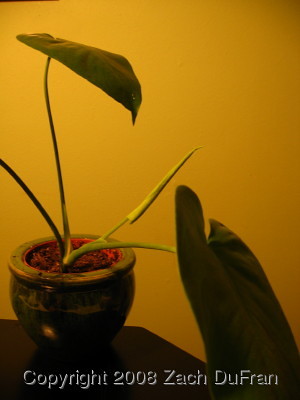 |
| Monstera deliciosa v. 'Borsigiana' - I wish this photo hadn't turned out so yellow... |
Common names for the Monstera genus include "Mexican breadfruit" and "Swiss cheese plant." The Monstera genus contains 22 species (according to wikipedia) and a number of naturally-occurring varieties and cultivars (human-cultivated varieties). I have 7 of these plants from 5 different species/varieties:
Monstera adansonii
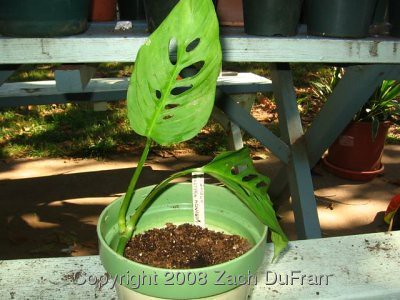 |
| my young Monstera adansonii |
This plant was sent to me a couple of months ago by my friend, aroid collector Russ Hammer. It is one of the vining types of Monstera with a small leaf initially. The two leaves on my plant are just about 5 inches long. If my plant were to reach full maturity (unlikely), the leaves could become 3 to 4 feet in length. Here is a picture of Russ's mature specimen (notice the size of the leaves in comparison with the hand):
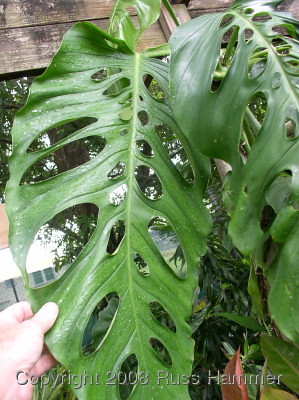 |
| mature Monstera adansonii |
Monstera deliciosa 'Borsigiana'
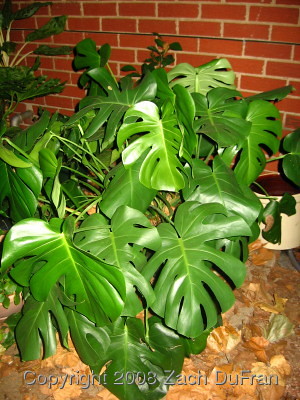 |
| Monstera deliciosa v. 'Borsigiana' |
Monstera deliciosa is the most common Monstera species, usually kept as a houseplant. Sometimes it is mislabeled as a split-leaf Philodendron. While the name "split-leaf" is perfectly applicable as a common name, the name Philodendron should only be applied to species that are in the Philodendron genus. [Way too many plants are called Philodendrons by common name that are not in the Philo genus.]
I have had this plant just about a year now and it has grown tremendously. I'm not sure where I'm going to put it next winter if it grows as much over the summer as it did this last year! This is a gorgeous plant. I'll probably just have to start separating it into a couple of pots and give some away. I guess I could also experiment a little, starting a plant as a climber. So far, my plant has just been a huge bush. But this plant really likes to climb, so I guess I could give that a shot if I decide to divide it next year.
Monstera deliciosa 'Borsigiana' variegated
 |
| Monstera deliciosa v. 'Borsigiana' variegated |
This is another plant given to me by my friend, Russ. It is a variegated variety of the plant above. The variegation is variable, from solid white leaves to solid green leaves and everything in between. One of my leaves is almost just perfectly half and half. My plant didn't get much time outside before the weather turned cold and it had to be brought indoors. So right now it is a fairly small specimen with just 4 leaves. I expect it to really take off next summer, though. I'd like to see this turn into the "monster" that my other deliciosa has become.
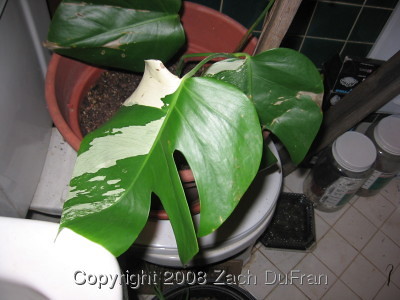 |
| Monstera deliciosa v. 'Borsigiana' variegated |
Monstera obliqua (aka Monstera friedrichstahlii)
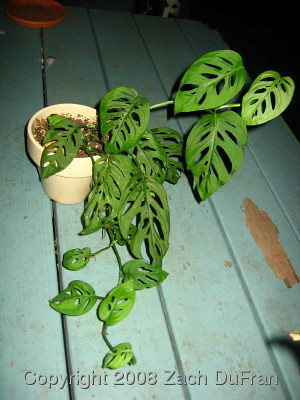 |
| Monstera obliqua / Monstera friedrichstahlii |
It seems that both of these names (obliqua and friedrichstahlii) refer to the same species of plant. The name friedrichstahlii seems to have fallen out of use recently. This species also closely resembles the species adansonii. The differences are more apparent when the inflorescence (blooming stage) and infructescence (fruiting stage) are observed. There is a discussion on the
Aroid forum that may be of help here. I haven't been lucky enough to see an inflorescence on any of my Monsteras yet, so I have to take someone else's word on the identification.
Monstera standleyana
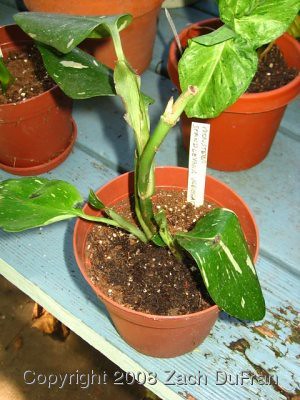 |
| Monstera standleyana |
This is a unique, climbing species of Monstera that is most frequently (as a houseplant) seen growing on a totem. It can become very dense, with the leaves closer on the stem than some other species. The leaves have some dappled variegation, as if some paint was dripped on them.
This is another plant that was given to me by Russ. I potted it up as soon as I received it, but it started looking bad about a week later. The leaves curled up into little scrolls and started to turn dark. I unpotted it and found that most of the roots were black and mushy. I pulled away the rotted roots and stuck the firm clipping in water in the windowsill. The cutting has been slow to put out new roots, but the leaves look better, having unravelled and flattened out. I plan to just leave the clipping in water until the Spring, at which time it should have enough roots to be put in dirt again and support itself.
New growth on my Monsteras
Unlike most of the plants I have to bring indoors for the winter, my Monsteras continue to growth. Here are a couple pictures of the beautiful new growth that I have been watching over the last couple of weeks.
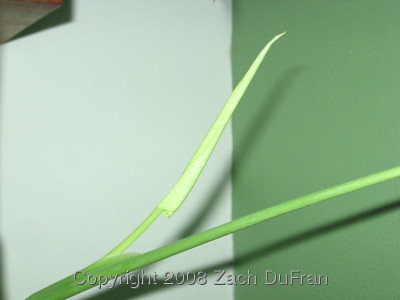 |
| new growth on small Monstera deliciosa v. 'Borsigiana' |
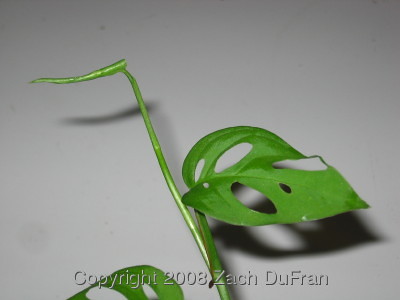 |
| new growth on Monstera obliqua |
In nature
Monsteras are found in central and tropical south America climbing up the trunks of trees in rainforests and jungles. They are epiphytic, meaning they will attach themselves to trees. However, epiphytes do not harm the host tree, as parasitic plants do. Monsteras display heteroblastic growth, changing leaf shape as they mature and climb higher into a tree. The fenestrations (holes in the leaves) are one of the most distinct attributes of the Monstera genus, though fenestrations do occur in other genera. Actually fenestrations only occur in the
Monsteroideae subfamily, a couple of other Aroid genera and an aquatic plant Aponogeton madagascariensis (Madagascar lace leaf plant). I have actually kept the madagascar lace leaf plant in my 29 gallon aquarium before. It is a very usual and interesting plant. For tree-climbing aroids, these fenestrations help the plants to weather wind in the upper branches, and prevent them from being pulled off the tree. And of course, they are the reason for the nickname "swiss cheese plant."
Care
Monsteras don't require any special sort of care. Generally, I keep mine in bright, indirect light. This means that they sit on my partially shaded (dappled light) back porch during the summer and are very happy. Otherwise they are in as much light as I can find inside the house during the winter. My M. obliquas usually have a couple of leaves turn yellow and fall off whenever I bring them indoors. I guess they just go into shock with the decreased light, because it has happened each year. The vining types (adansonii, obliqua) are very easy to propagate by serpentine layering or simply sticking cuttings in a glass of water in the windowsill.
As I mentioned in a
previous post, I have propagated my M. deliciosa by sticking a leaf with attached stem into a glass of water, too. I was surprised to see roots grow from the base of the stem, since the piece didn't even have a single node on it. But it sent out roots in a matter of days!
If you're interested in seeing some more Monsteras, there are lots of good pictures of Aroids over at
http://aroidpictures.fr. Here's a direct link to the
Monstera pics.










They are great plants! My brother has one called Emmenthal, as in the UK they're called swiss cheese plants (because of the holes), and it's taking over their living room.
ReplyDeleteInterestingly enough, I divided and brought in half of my Colocasia esculenta, and both the indoor ones have grown new leaves. I haven't had a good look at my outdoor ones, but even they are in the greenhouse, which hit a balmy 25C today - wish I was as warm in my house!
I want to know how to differentiate Rhaphidophora from Monstera-Adansonii
ReplyDeletei recently purchased a Monstera adansonii, and after seeing these pictures, i am very afraid that it will outgrow my apartment, considering it already has leaves as long as 9 inches...
ReplyDeleteMatt-
ReplyDeleteI wouldn't be too worried about that plant outgrowing your apartment. In time, perhaps. But in an indoor setting, it will probably stay a reasonable size. And you can always prune it, put the cuttings in water to let them root, and then give them to friends!
I really like the philodendron adansonii plant. Do you have any cuttings available? I really like this plant. Thanks!
ReplyDeleteMy mistake I meant that I like the philodendron oblique and if you can send a cutting.
ReplyDeleteHello. My name is Noel Calvert. Loved your pictures, & thought I would help you out with a little information. Since you mentioned that you are interested in classification, I thought I would chime in & help you with some of your plants.
ReplyDeleteThe plant you have listed as Monstera obliqua (aka Monstera friedrichstahlii) is actually Monstera adansonii. Monstera friedrichstahlii is what is called a synonym in scientific names. That means it was a name given after the plant was named & described to science. The reason for this is how variable aroids are. Many of them have been described multiple times to science mistakenly due to variability.
The name Monstera obliqua refers to this plant which looks very little like Monstera adansonii. (See link) http://www.exoticatropicals.com/big-leaf-jungle-plants/monstera-obliqua-swiss-cheese-vine/
Hi! I was hoping you might be able to answer a question that I have about my monstera adansonii/friedrichstahlii/obliqua (I am not sure which! I have never had the chance to have someone who would know better take a look at it, but it looks like the pictures you have posted here of both the adansonii and the obliqua). I got it about a year and a half ago, and immediately almost killed it by closing the drapes on the window sill it was sitting on during a 100+ day and forgot to remove it. Anyway, I loved it so much I thought I'd just leave the few leaves that didn't fry completely on there, and try to baby it by keeping it watered and in bright, indirect life. Luckily it came back to life, and has been pretty happy ever since. It is now in a relatively dark corner - no windows very near by, although the space tends to feel bright with natural light during the day. I have never re-potted it, but give it fertilizer every month or so during the summer.
ReplyDeleteAnyway, quite a while ago (maybe like 9 months ago) I noticed that a leaf here and there would turn yellow and then brown. Besides that it seemed healthy, so I always just pluck those leaves and don't worry too much. But in the last few months, I have noticed the leaves starting to develop a splotchiness - first just a lighter green, and now those splotches are becoming yellow. This is not happening on all the branches of the plant evenly - it seems to be most pronounced in some of the mid-length ones (they are about 3 feet long). Have you ever had/heard of this problem? I have tried to look all over the internet and haven't seen anyone talk about this! I'd really appreciate any information you might have, or if you know of someone else who I should contact.
Thanks!!!